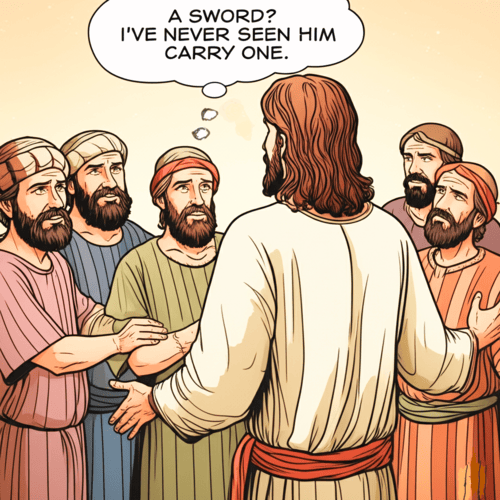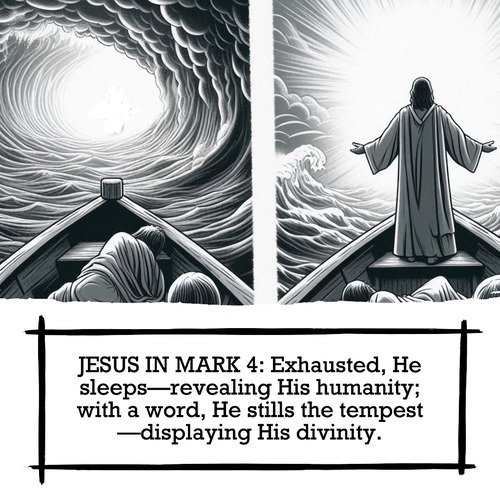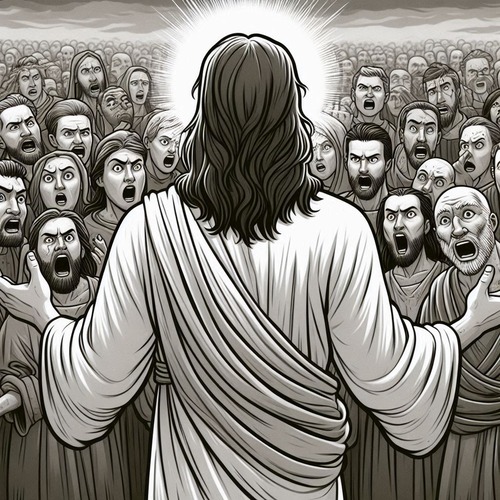Why do We Affirm Jesus is Fully God and Fully Man?
In the incarnation of Jesus, we witness divine love made tangible—the eternal God embracing human frailty out of boundless compassion for us, when He clearly didn’t need to, otherwise…
The Hypostatic Union—the belief that Jesus is both fully God and fully man—is central to Christian theology. The doctrine is crucial to our understanding of salvation and indeed, of our loving Saviour. Join us, as we explore why the doctrine of Jesus’ dual nature is one we shall do well both to study and affirm.
The Scriptural Basis: The New Testament provides numerous examples affirming both Christ’s divinity and humanity:
- Divinity: The Gospel of John opens with a profound declaration of Jesus’ divine nature—He is the eternal Word that was both with God and was God (John 1:1). This same Word, we’re told, became flesh and dwelt among us (John 1:14). Paul writes (in Colossians 2:9) that in Christ all the fullness of the Deity lives in bodily form, a striking affirmation of Jesus’ complete divinity. The author of Hebrews describes Jesus as the radiance of God’s glory and the exact representation of His being, further emphasizing Christ’s divine nature (Hebrews 1:3).
- Humanity: Luke provides a glimpse into Jesus’ human development, noting He grew in wisdom and stature, and in favour with God and man (Luke 2:52). This portrays a very human process of growth and maturation. Hebrews tells us Jesus was tempted in every way, just as we are, yet without sin—a clear indication of His genuine human experience (Hebrews 4:15). Paul explicitly refers to Jesus as a man, the mediator between God and humanity (1 Timothy 2:5).
Why is the Dual Nature Important? The dual nature of Christ is critical for several reasons:
- Salvation: Only God can save humanity from sin, but only a man can represent humanity and pay the price for human sin. Jesus, as both God and man, bridges this gap. His divine nature gives His sacrifice infinite value, capable of atoning for all sin. His human nature allows Him to stand in our place, taking the punishment we deserve.
- Mediation: As both God and man, Jesus can perfectly mediate between God and humanity. He understands both perspectives completely. He can represent humanity to God and God to humanity in a way no one else could (1 Timothy 2:5).
- Empathy: Christ’s human nature allows Him to empathize with human struggles. He experienced fatigue, hunger, temptation, rejection, and even death. This means He can truly understand our experiences and intercede for us with firsthand knowledge of human suffering (Hebrews 4:15).
- Revelation: In Jesus, we see both the fullness of God and the ideal of humanity. He reveals God’s character in human form, showing us what God is like in a way we can understand. At the same time, He demonstrates perfect humanity, showing us what we were meant to be and what we can become through Him (Colossians 1:15-20). The revelation of Jesus’ dual nature also speaks to us of His love: He took on human form only for our sakes, when He clearly didn’t need to otherwise.
Examples of Both Natures:
Divinity: Jesus forgave sins (Mark 2:5-7), accepted worship from His disciples without rebuking them (Matthew 14:33), performed miracles that demonstrated His power over nature, disease, and even death: He raised Lazarus from the dead after four days in the tomb, calling him out with a command (John 11:43-44).
Humanity: Jesus’ human nature is evident throughout the Gospels. After fasting for 40 days in the wilderness, He was hungry, showing His human need for food (Matthew 4:2). We see Him growing tired from His journeys, as when He rested at Jacob’s well while His disciples went to buy food (John 4:6). Jesus experienced the full range of human emotions. He wept at the tomb of Lazarus, expressed anger at the money changers in the temple, and in Gethsemane, He felt anguish as He contemplated His coming crucifixion. Ultimately, Jesus experienced death itself (Luke 23:46).
The Holy Spirit has lovingly woven into the gospel accounts these intricate details of Jesus’ human frailty—His exhaustion, hunger, thirst, and sorrow—so we may fully grasp the depth of His incarnation. Consider this: what compelled Christ to embrace these mortal limitations when in His divinity He didn’t need to?
The Chalcedonian Definition: The Chalcedonian Creed, formulated in 451 AD, clarified and defined the orthodox Christian understanding of the hypostatic union. Among other things, the definition states Jesus’ two natures exist:
- Without Confusion: Jesus is not a mix of divine and human natures creating something entirely new—like, say, two colours combining to form a third colour. He remains fully God and fully man.
- Without Change: When the Logos took on human flesh, He did not stop being God. The incarnation did not alter His divine nature.
- Without Division: Jesus is not split into two persons; He is wholly God and wholly man in one person.
- Without Separation: The divine and human natures in Jesus are united in a real, integral, organic way, not just a moral or relational partnership.
Why Does the Hypostatic Union Matter? The hypostatic union, the belief that Jesus is both fully divine and fully human, matters for two main reasons:
If Jesus Isn’t Divine: Jesus being God is a cornerstone of the Christian faith. If Jesus is not God, our faith is meaningless, and as Paul says, “we are of all people most to be pitied” (1 Corinthians 15:19). Our hope is gone if Jesus isn’t divine. Only God could endure His own wrath and survive. If Jesus wasn’t God in the flesh, He would have to become sinful to be able to die for our sins.
If Jesus Isn’t Human: If Jesus wasn’t human, He couldn’t represent humanity. Just as all are condemned in Adam, we needed another representative to live a righteous life before God (Romans 5:18). Without His humanity, Jesus couldn’t stand in our place.
Does Jesus Still Have a Dual Nature Post-Resurrection? Yes, Christian theology affirms Jesus remains both fully God and fully man even after His resurrection and ascension. This is evidenced by several key points in Scripture and theological reasoning:
His physical resurrection body: After His resurrection, Jesus went to great lengths to demonstrate the physical reality of His resurrected body (Luke 24:39).
His ascension in bodily form (Acts 1:9): The account of Jesus’ ascension in Acts describes Him being taken up before the disciples’ eyes, with a cloud hiding Him from their sight. This imagery strongly suggests a physical, bodily ascension rather than a spiritual disappearance.
His ongoing role as mediator: New Testament writings (1 Timothy 2:5, Hebrews 7:25) continue to speak of Jesus as our mediator and intercessor even after His ascension. This role requires both His divine nature to represent God and His human nature to represent humanity.
Descriptions of the glorified Christ (e.g., Revelation 1:13-16): The apostle John’s vision of the glorified Christ in Revelation provides a striking image that combines both human and divine elements. John describes Jesus in terms reminiscent of both the “Son of Man” from Daniel and divine figures from Old Testament theophanies. This vision portrays Christ as retaining both His human and divine natures in His glorified state.
Reasons for Continued Affirmation: Christians continue to affirm Christ’s dual nature post-resurrection because:
- It maintains the integrity of the Incarnation: God’s commitment to humanity didn’t end at the cross or resurrection.
- It gives hope for our own resurrection: Christ’s glorified human body is a prototype for our future resurrection bodies (1 Corinthians 15:20-23).
- It assures us of Christ’s ongoing empathy and intercession: He continues to understand and represent us before the Father (Romans 8:34).
- It fullfills Old Testament prophecies about the Messiah’s eternal reign as both divine King and Son of David (Isaiah 9:6-7, Luke 1:32-33).
Conclusion: The affirmation of Jesus as fully God and fully man is thus not just a theological abstraction, but a foundational belief that impacts how Christians understand God’s nature, salvation, and their own relationship with God. It provides assurance of God’s love, empathy, and ongoing commitment to humanity, while also maintaining the unique salvific role of Christ in Christian theology. In the incarnation of Jesus, we witness divine love made tangible—the eternal God embracing human frailty out of boundless compassion for us, when He clearly didn’t need to, otherwise.
Related Reads:
- The Virgin Birth: Why Do We Affirm It?
- Stop the Search: Jesus is The Promised Messiah
- Exploring the Historicity of Jesus: Facts and Evidence
- Five Eyewitnesses of the Resurrection: Their Compelling Testimony
- Types of Christ and His Cross in the Old Testament
Jesus Fully God Fully Man—Related FAQs
What is the heresy of Docetism and what makes it wrong? Docetism (from the Greek “dokein,” meaning “to seem”) taught that Jesus only appeared to be human but wasn’t actually flesh and blood. This heresy fundamentally denies the reality of Christ’s incarnation and suffering, making His death a mere illusion. Reformed theology rejects this because Scripture clearly teaches that “the Word became flesh” (John 1:14) and that Christ had to share in our humanity to be our perfect high priest (Hebrews 2:14-17). Without a real human nature, Jesus could not truly represent us or die in our place.
How does the heresy of Nestorianism misunderstand the person of Christ? Nestorianism erroneously taught Jesus consisted of two separate persons—one divine and one human—rather than one person with two natures. This effectively splits Christ into two beings, destroying the unity of His person essential for our salvation. Reformed theology insists on the singular personhood of Christ because only a genuinely unified divine-human person could both die for us and serve as the one mediator between God and man (1 Timothy 2:5).
What makes Adoptionism a heresy in the view of Reformed soteriology? Adoptionism claimed Jesus was born merely human and was later “adopted” as God’s Son, usually at His baptism. This heresy fundamentally undermines the eternal Sonship of Christ and the doctrine of election, both crucial to Reformed theology. Scripture teaches Jesus is the eternal Son of God who took on human nature (John 1:1-14), not a human being who achieved divine status.
Why does Reformed theology reject Arianism? Arianism taught Jesus was a created being—the highest of all creatures but still less than fully God. This heresy strikes at the heart of Christ’s deity and ability to save, since only God Himself could bear infinite divine wrath and provide infinite merit for His people. Reformed theology, following Scripture, maintains that Jesus is “very God of very God,” equal with the Father in essence and eternality.
What are the practical implications of the hypostatic union for Christian life? The hypostatic union assures believers that Christ fully understands human experience while possessing divine power to help us. It means our prayers are heard by one who has experienced human weakness yet has divine authority to answer them. Reformed theology particularly emphasizes how this doctrine gives assurance in sanctification—Christ’s human nature guarantees His sympathy with our struggles, while His divine nature guarantees His power to conform us to His image.
Editor’s Pick

What Did Jesus Mean: ‘I Bring Not Peace But a Sword’?
Jesus’ statement may sound perplexing to us at first read: "Do not think that I have come to bring peace [...]

The Beatitudes: The Nine Marks of Those Jesus Calls Blessed
When Jesus climbed that hillside in Galilee and began to speak, He turned the world's understanding of blessing upside down. [...]

Sacred Sorrow: Why Jesus Calls Mourning a Blessing
MAKING SENSE OF THE DIVINE PARADOX IN MATTHEW 5:4 When Jesus declared, “Blessed are those who mourn, for they will [...]

‘Sell Everything You Have…’: Are We To Do So Literally?
When Jesus encountered the rich young ruler in Matthew 19:21, His words cut through with startling clarity: “If you want [...]

Why Jesus Said ‘It’s Better I Go Away’…
THE SUPERIOR GIFT OF THE HOLY SPIRIT “Nevertheless, I tell you the truth: it is to your advantage that I [...]

What About Those Who’ve Never Heard the Gospel?…
WILL GOD SHOW THEM MERCY ON JUDGEMENT DAY? Few questions tug at the Christian’s heart like this one. Picture the [...]

Cities of Refuge: Foreshadowing Our Safe Haven in Jesus
Picture this: A man is chopping wood with his neighbour when the axe head flies off the handle, striking and [...]

Testament to Design: The Engineering Marvel of Elephants
Picture an African elephant delicately plucking a single acacia leaf with the tip of its trunk, then moments later using [...]

Blue Whales: Mammoth Icons of Intelligent Design
Imagine an animal so massive its heart alone weighs as much as a small car, yet so precisely engineered it [...]

Do Unbelieving Kids Disqualify Church Leaders?
REFORMED PERSPECTIVES ON 1 TIMOTHY 3 AND ELDER QUALIFICATIONS Every pastor knows the heartbreak. A faithful elder who has served [...]





